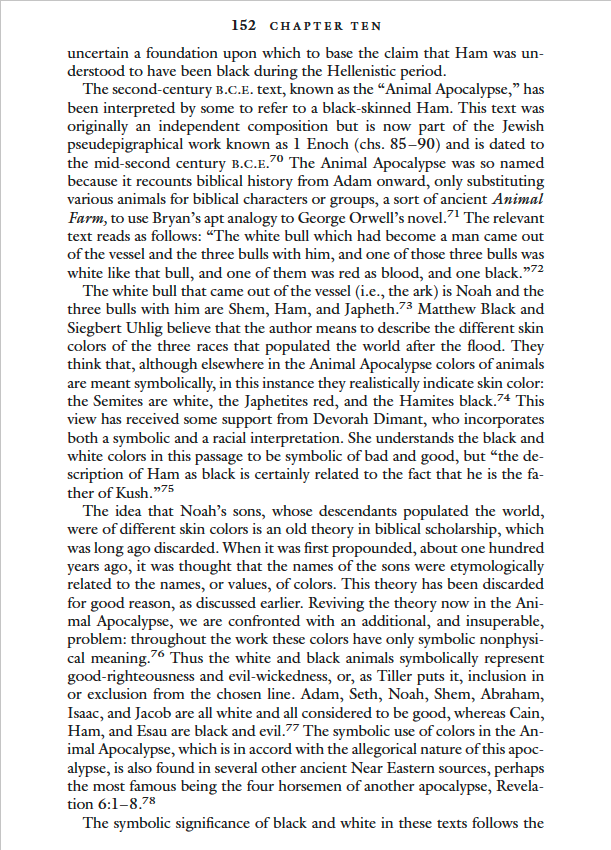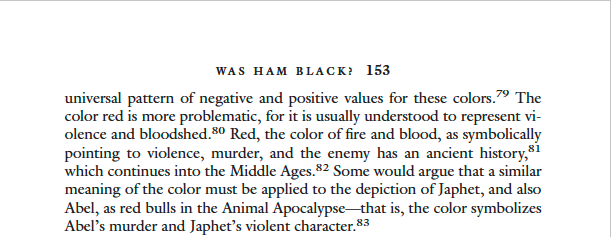Goldenberg reviews the interpretation of the color symbolism of the Animal Apocalypse.
- Type
- Academic / Technical Report
- Source
- David Goldenberg Non-LDS
- Hearsay
- Direct
- Reference
David Goldenberg, The Curse of Ham: Race and Slavery in Early Judaism, Christianity, and Islam (Princeton: Princeton University Press, 2003), 152–153
- Scribe/Publisher
- Princeton University Press
- Audience
- Reading Public
- Transcription
The second-century B.C.E. text, known as the “Animal Apocalypse,” has been interpreted by some to refer to a black-skinned Ham. This text was originally an independent composition but is now part of the Jewish pseudepigraphical work known as 1 Enoch (chs. 85–90) and is dated to the mid-second century B.C.E.70 The Animal Apocalypse was so named because it recounts biblical history from Adam onward, only substituting various animals for biblical characters or groups, a sort of ancient Animal Farm, to use Bryan’s apt analogy to George Orwell’s novel.71 The relevant text reads as follows: “The white bull which had become a man came out of the vessel and the three bulls with him, and one of those three bulls was white like that bull, and one of them was red as blood, and one black.”72
The white bull that came out of the vessel (i.e., the ark) is Noah and the three bulls with him are Shem, Ham, and Japheth.73 Matthew Black and Siegbert Uhlig believe that the author means to describe the different skin colors of the three races that populated the world after the flood. They think that, although elsewhere in the Animal Apocalypse colors of animals are meant symbolically, in this instance they realistically indicate skin color: the Semites are white, the Japhetites red, and the Hamites black.74 This view has received some support from Devorah Dimant, who incorporates both a symbolic and a racial interpretation. She understands the black and white colors in this passage to be symbolic of bad and good, but “the description of Ham as black is certainly related to the fact that he is the father of Kush.”75
The idea that Noah’s sons, whose descendants populated the world, were of different skin colors is an old theory in biblical scholarship, which was long ago discarded. When it was first propounded, about one hundred years ago, it was thought that the names of the sons were etymologically related to the names, or values, of colors. This theory has been discarded for good reason, as discussed earlier. Reviving the theory now in the Animal Apocalypse, we are confronted with an additional, and insuperable, problem: throughout the work these colors have only symbolic nonphysical meaning.76 Thus the white and black animals symbolically represent good-righteousness and evil-wickedness, or, as Tiller puts it, inclusion in or exclusion from the chosen line. Adam, Seth, Noah, Shem, Abraham, Isaac, and Jacob are all white and all considered to be good, whereas Cain, Ham, and Esau are black and evil.77 The symbolic use of colors in the Animal Apocalypse, which is in accord with the allegorical nature of this apocalypse, is also found in several other ancient Near Eastern sources, perhaps the most famous being the four horsemen of another apocalypse, Revelation 6:1–8.78
The symbolic significance of black and white in these texts follows the universal pattern of negative and positive values for these colors.79 The color red is more problematic, for it is usually understood to represent violence and bloodshed.80 Red, the color of fire and blood, as symbolically pointing to violence, murder, and the enemy has an ancient history,81 which continues into the Middle Ages.82 Some would argue that a similar meaning of the color must be applied to the depiction of Japhet, and also Abel, as red bulls in the Animal Apocalypse—that is, the color symbolizes Abel’s murder and Japhet’s violent character.
- Citations in Mormonr Qnas
The B. H. Roberts Foundation is not owned by, operated by, or affiliated with the Church of Jesus Christ of Latter-day Saints.


